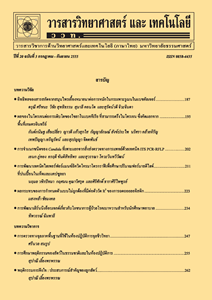ความผันแปรของอุณหภูมิร่างกายของกระบือปลักสาวที่เลี้ยงแบบขังคอกและปล่อยแทะเล็มในช่วงฤดูหนาว
Main Article Content
Abstract
บทคัดย่อ
ศึกษาความสัมพันธ์ระหว่างปัจจัยทางอุตุนิยมวิทยาที่ส่งผลต่ออุณหภูมิร่างกายและพฤติกรรมของกระบือปลัก ในช่วงต้นฤดูหนาว ณ ศูนย์วิจัยและบำรุงพันธุ์สัตว์สุรินทร์ จังหวัดสุรินทร์ กระบือปลักสาวอายุ 2 ปี จำนวน 12 ตัว ถูกแบ่งออกเป็น 2 กลุ่ม โดยให้แต่ละกลุ่มมีน้ำหนักตัวเฉลี่ยใกล้เคียงกัน กระบือสาวจำนวน 6 ตัว ถูกเลี้ยงไว้ในคอก ซึ่งแบ่งออกเป็นส่วนที่มีหลังคาสังกะสีคลุมและพื้นโล่ง ในแต่ละวันจะได้รับหญ้ารูซี่สดอย่างเต็มที่ โดยจะให้ในเวลา 07:30 12:00 และ 15:00 น. ส่วนกระบือสาวอีก 6 ตัว ถูกปล่อยแทะเล็มแบบจำเจในแปลงหญ้ารูซี่ ขนาด 6 ไร่ ซึ่งมีต้นไม้ขนาดใหญ่ขึ้นอยู่ ทำการสุ่มกระบือ 2 ตัว จากแต่ละกลุ่ม เพื่อติดอุปกรณ์บันทึกข้อมูลอัตโนมัติบันทึกอุณหภูมิใกล้เยื่อแก้วหู ทุกๆ 1 นาที ตั้งแต่เวลา 06:00-18:00 น. และบันทึกพฤติกรรมโดยใช้วิธีการสังเกตสัตว์แต่ละตัวโดยตรงทุกๆ 1 นาที ในช่วงเวลาเดียวกัน ผลจากการศึกษาพบว่าอุณหภูมิร่างกายของกระบือมีสหสัมพันธ์สูงกับอุณหภูมิอากาศ (r=0.80-0.89) และดัชนีอุณหภูมิ-ความชื้น (r=0.80-0.90) และมีสหสัมพันธ์ปานกลางกับอุณหภูมิตุ้มดำ (r=0.77-0.78) และรังสีอาทิตย์ (r=0.54-0.59) กระบือที่เลี้ยงในคอกและในแปลงหญ้าใช้เวลาทำกิจกรรมต่างๆ ในช่วงกลางวันแตกต่างอย่างไม่มีนัยสำคัญทางสถิติ (P>0.05) จากการศึกษาครั้งนี้ชี้ให้เห็นว่าอุณหภูมิอากาศและดัชนีอุณหภูมิ-ความชื้น สามารถใช้เป็นดัชนีบ่งชี้การเกิดความเครียดจากความร้อนของกระบือได้ดี ทั้งในสภาพการเลี้ยงแบบขังคอกและปล่อย
แทะเล็ม
คำสำคัญ : กระบือปลัก; อุณหภูมิร่างกาย; พฤติกรรม; ฤดูหนาว
Abstract
The study was undertaken during early winter at Surin Livestock Research and Breeding Center, Surin Province to investigate interrelations among meteorological factors potentially affecting the body temperature and behaviour of swamp buffaloes. Twelve 2-year-old swamp buffalo heifers were divided into two groups, each of six heifers, with the mean group weights being as similar as possible. Six heifers were kept in corral, which was divided into a shaded area, covered by corrugated metal-sheet roof, and an open un-shaded area. Fresh ruzi grass was offered ad libitum at approximately 07:30, 12:00 and 15:00 h each day. The other six heifers were continuously stocked on an area of 6 rai ruzi pasture, which contained large trees. Two heifers in each group were randomly assigned to be fitted with portable data loggers to record the tympanic temperature at 1-min intervals from 06:00 to 18:00. Animal activity was also monitored individually by visual observation at 1-min intervals during the same period. The result showed that the body temperature was highly correlated with the air temperature (r=0.80-0.89) and the temperature-humidity index (r=0.80-0.90), while its correlations with black-globe temperature (r=0.77-0.78) and solar radiation were moderate (r=0.54-0.59). During daytime, the times spent in all activity were not significantly different (P>0.05) between the indoor and grazed buffaloes. It was suggested that the air temperature and temperature-humidity index be good indicators of the stress imposed by the environment, either for buffaloes kept indoor or in the pasture.
Keywords: swamp buffalo; body temperature; behaviour; winter season


